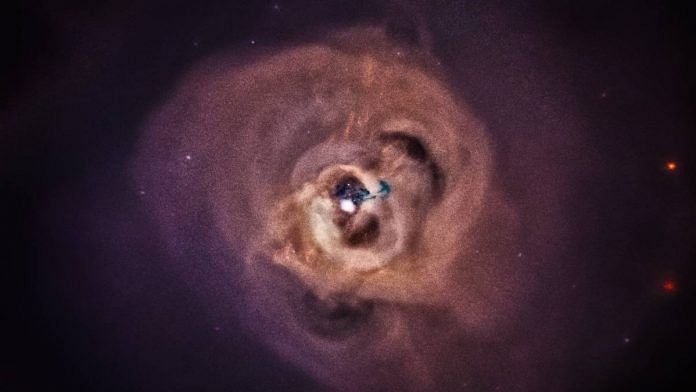New Delhi: NASA has released a sound clip from a blackhole at the center of the Perseus galaxy cluster, which contains noises made by it.
Since 2003, the black hole at the center of the Perseus galaxy cluster has been associated with sound. This is because astronomers discovered that pressure waves sent out by the black hole caused ripples in the cluster’s hot gas that could be translated into a sound note — one that humans cannot hear.
Now a new sonification brings more notes to this black hole.
The sonification revisits the actual sound waves discovered in data from NASA’s Chandra X-ray Observatory. The popular misconception that there is no sound in space originates with the fact that most of space is essentially a vacuum, providing no medium for sound waves to propagate through.
A galaxy cluster, on the other hand, has copious amounts of gas that envelop the hundreds or even thousands of galaxies within it, providing a medium for the sound waves to travel.
In this new sonification of Perseus, the sound waves astronomers had previously identified, were extracted and made audible for the first time.
The signals were resynthesised into the range of human hearing. Read more.
Largest native American cave artwork mapped in 3D
Scientists from the University of Tennessee have revealed the largest ancient native American cave artwork, inscribed in Alabama, using 3D photogrammetry.
The cave is known in scientific literature as the 19th Unnamed Cave — its real name has been concealed to protect the artwork. Scientists have found numerous sketches on the walls and ceilings of the cave.
While the etchings on the wall could not be dated, researchers were able to date carbon left behind by torches carried by the artists. These reveal that the artworks in the cave were created approximately 1,200 to 1,700 years ago.
Pottery shards have also been found on the cave floor, and they have been dated to between 1,000 and 3,000 years ago. The etchings included representations of people engaged in various activities, with many of the images being life-size.
Using LED lights, a digital camera, and a photo rig that allowed 3D photogrammetry — a technique that involves combining overlapping photographs to add more information to an image — the team was able to capture the hidden features on the surface.
They have also created a 3D virtual map of the cave.
The researchers suggest the art in the cave represents the largest known example of cave art in North America, and is comparable to the rock art generally seen only in the American Southwest. Read more.
Also read: Scientists discover 6-million-year-old fossil of day-hunting owl in China
Water on moon may have come from Earth
A study researchers from the University of Alaska Fairbanks suggests that water and ice found on moon may be a result of hydrogen and oxygen ions escaping from Earth’s upper atmosphere and combining in the lunar surface
The work adds to a growing body of research about water found on the moon’s north and south poles. Finding water is key to the planned long-term human presence on the moon.
The new research estimates the moon’s polar regions could hold up to 3,500 cubic kilometers or more of surface permafrost, or subsurface liquid water, created from ions that escaped Earth’s atmosphere.
The presence of the moon in the Earth’s magnetosphere’s tail — known as the magnetotail — temporarily affects some of Earth’s magnetic field lines, those that are broken, and which simply trail off into space for many thousands of miles.
Not all of Earth’s field lines are attached to the planet at both ends, some have only one attachment point.
The moon’s presence in the magnetotail causes some of these broken field lines to reconnect with their opposing broken counterpart. When that happens, hydrogen and oxygen ions that had escaped Earth rush to those reconnected field lines and are accelerated back toward Earth.
The researchers suggest many of those returning ions hit the passing moon, which has no magnetosphere of its own to repel them. The ions then combine to form the lunar permafrost. Some of that, through geologic and other processes, such as asteroid impacts, is driven below the surface, where it can become liquid water. Read more.
Gut microbes linked to common type of stroke
Scientists believe have identified specific groups of gut microbes that could increase or decrease someone’s risk of suffering the most common type of stroke —isechaemic stroke, where a blood clot blocks the flow of oxygen to the brain.
The research by Sant Pau Research Institute in Barcelona, Spain adds to growing evidence that alterations in the microbiome living in our gut could play a role in cardiovascular disease.
Previous studies have suggested that certain microbes may influence the formation of atherosclerotic plaques in the arteries, and that the gut microbiomes of stroke patients differ from those of healthy people.
To investigate whether they may also influence people’s recovery from stroke, researchers took stool samples from 89 people who had very recently suffered an ischaemic stroke, as well as from healthy individuals.
They performed DNA sequencing to identify the different microorganisms present in their guts, and whether certain groups of bacteria correlated with their functional recovery. Read more.
(Edited by Poulomi Banerjee)
Also read: Survey of largest archival of Hubble data reveals why some planets are hot



